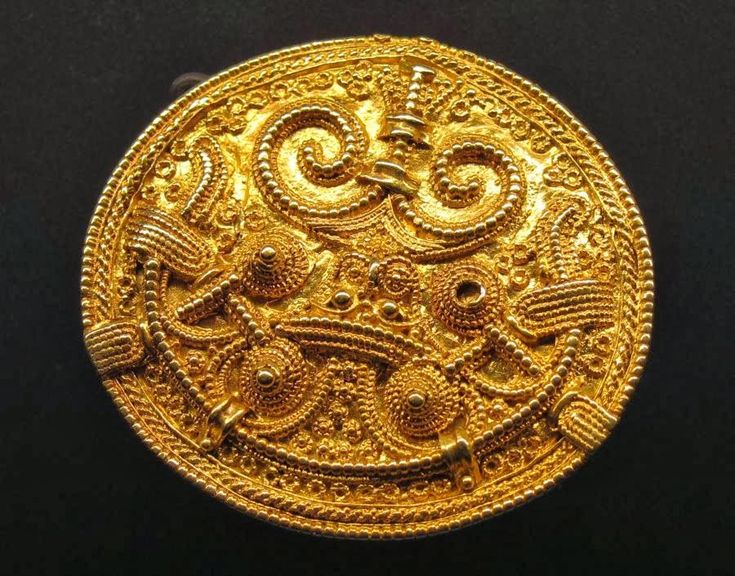The Viking gold trade played a crucial role in the movement of wealth across medieval Europe. While much of Western Europe had shifted to a silver-based economy, the Vikings continued to acquire and circulate gold through raiding, trade, and mercenary service. Their infamous attacks on monasteries and cities provided them with vast amounts of gold artifacts and coins, while their extensive trade networks connected Scandinavia to Byzantium, the Islamic Caliphates, and Western Europe. Additionally, Viking leaders accumulated enormous gold hoards, revealing how plundered and traded gold spread across the continent.
Unlike the Carolingians, who favored silver, the Vikings highly valued gold for status symbols, religious artifacts, and wealth storage. Viking gold hoards, found across Scandinavia and the British Isles, reveal how gold flowed through their vast network of raids, trade, and mercenary service.

Raiding for Gold: The Viking Plunder Economy
Beginning in the late 8th century, Viking raids targeted wealthy monasteries and cities across Europe, particularly in Britain, Ireland, and Francia. These locations were rich in gold artifacts, coins, and religious treasures, making them prime targets.
Key Sources of Viking Plundered Gold
- Anglo-Saxon and Frankish Monasteries – Vikings looted churches and monasteries, where gold was used for religious decorations, chalices, and books.
- Byzantine and Islamic Wealth – Vikings acquired gold coins and treasures from raids in the Mediterranean, especially after attacking Muslim and Byzantine settlements.
- Ransoms and Tribute (Danegeld) – European rulers, particularly in England and Francia, paid the Vikings large amounts of gold and silver to prevent further attacks.
- Example: King Æthelred the Unready of England paid vast sums of Danegeld (tribute payments) to Viking leaders in the 10th and 11th centuries.
The Viking Trade Network: Gold Beyond Raiding
While raiding was a key way Vikings obtained gold, they were also skilled merchants, establishing trade routes that linked Scandinavia, Europe, the Middle East, and Asia. These trade connections allowed Vikings to acquire and redistribute gold across different regions.
Major Viking Trade Routes for Gold
- Byzantine Empire (Miklagard / Constantinople)
- Viking mercenaries served in the Byzantine Varangian Guard, earning gold solidi as payment.
- The Byzantines also traded gold jewelry and coins with Viking merchants.
- Islamic Caliphates (Abbasid & Umayyad Spain)
- Vikings traded furs, slaves, and amber for Islamic gold dinars from the Middle East and North Africa.
- Frankish and Anglo-Saxon Kingdoms
- Gold flowed into Viking hands through trade and tribute payments.
Viking Gold Hoards: Hidden Treasures of the North
Due to their wealth accumulation, Vikings buried large quantities of gold and silver in hoards. These hoards, discovered across Scandinavia, Britain, and Ireland, provide valuable insight into how gold moved through Viking hands.
Famous Viking Gold Hoards
- The Hiddensee Hoard (Germany, 10th Century)
- A Viking treasure trove containing gold jewelry and coins, likely linked to Danish Viking rulers.
- The Cuerdale Hoard (England, 9th Century)
- One of the largest Viking hoards ever found, containing gold and silver from both Western Europe and the Islamic world.
- The Spillings Hoard (Sweden, 9th–10th Century)
- A vast collection of gold and silver coins, including Byzantine and Islamic dinars, showcasing Viking trade connections.
The Viking Legacy in Medieval Gold Circulation
Viking interactions with Europe, Byzantium, and the Islamic world ensured that gold continued to circulate in Western Europe, despite the Carolingians’ focus on silver. Their raids, trade, and mercenary service helped reintroduce gold coinage and artifacts into areas that had moved toward silver-based economies.
By the 11th century, Viking-controlled territories, such as Normandy and parts of England, began adopting gold coinage again, paving the way for the later medieval gold currencies of the 13th–15th centuries.
Conclusion: Vikings as Key Players in Medieval Gold Trade
The Vikings, through raiding, trade, and diplomacy, played a crucial role in gold circulation across medieval Europe. While Western rulers like Charlemagne focused on silver, the Vikings maintained direct access to Byzantine and Islamic gold through their expansive trade networks and military service. Their gold hoards, payments in Danegeld, and commercial activities ensured that gold remained relevant in European economies, even during the height of silver dominance.
